Effect of Sand Fines Concentration on the Erosion-Corrosion Mechanism of Carbon Steel 90° Elbow Pipe in Slug Flow
Abstract
:1. Introduction
2. Experimental Methods and Materials
Multiphase Flow Loop Apparatus and Medium
3. Results and Discussion
3.1. Multilayer Paint Modeling (MPM)
3.2. Surface Topographies and SEM Analysis
3.3. EDS (Energy-Dispersive X-ray Spectroscopy) Analysis
3.4. Mass Loss
4. Conclusions
- The erosion-corrosion mechanism diversified substantially with the increase in sand fines concentration in slug flow. From mass loss rate measurements, erosion-corrosion of AISI 1018 CS in 10 wt.% sand fines concentration increased up to 93% relative to the 2 wt.% sand fines concentration for slug flow conditions.
- The microscopic images and surface topography of elbow exit surfaces reveal that impact of sand fines leads to the development of circular, elongated, and coalescence under slug flow conditions. In addition, plastic deformation and metal cutting increases with an increase of sand fines concentration and incurred strain hardening and make the internal surface extremely susceptible to corrosion.
- For 2 wt.% and 5 wt.% sand fines concentration in slug flow, the maximum particle wall impaction always occurs on the outer arch of the elbow between 60 and 90 degrees downstream adjacent to the outlet. Furthermore, examining 10 wt.% sand fines concentration showed erosion hotspot extended between 30 and 90 degrees downstream as the concentration increases.
- Under horizontal erosive slug flow conditions, an increase in sand fines concentration significantly increased degradation rate in the upper half section, the maximum erosion was found in the top of the elbow for all levels of concentration in the carrier phase. Additionally, the surface morphologies and EDS show that there are corrosion products around and inside the pitting holes perforated on the surface of the elbow after the test.
Supplementary Materials
Author Contributions
Funding
Acknowledgments
Conflicts of Interest
References
- Mansoori, H.; Esmaeilzadeh, F.; Mowla, D.; Mohammadi, A.H. Case study: Production benefits from increasing C-values. Oil Gas J. 2013, 111, 64–73. [Google Scholar]
- Burson-Thomas, C.B.; Wood, R.J.K. Developments in Erosion–Corrosion Over the Past 10 Years. J. Bio Tribo Corros. 2017, 3, 14. [Google Scholar] [CrossRef] [Green Version]
- Khan, R.; Ya, H.H.; Pao, W.; bin Abdullah, M.Z.; Dzubir, F.A. Influence of sand fines transport velocity on erosion-corrosion phenomena of carbon steel 90-degree elbow. Metals 2020, 10, 626. [Google Scholar] [CrossRef]
- Khan, R. Numerical investigation of the influence of sand particle concentration on long radius elbow erosion for liquid-solid flow. Int. J. Eng. 2019, 32, 1485–1490. [Google Scholar] [CrossRef]
- Khan, M.R.; Ya, H.H.; Pao, W.; Majid, M.A.A. Numerical Investigation of Sand Particle Erosion in Long Radius Elbow for Multiphase Flow. In Advances in Material Sciences and Engineering; Springer: Singapore, 2020; pp. 41–49. [Google Scholar]
- Kang, R.; Liu, H. An integrated model of predicting sand erosion in elbows for multiphase flows. Powder Technol. 2020, 366, 508–519. [Google Scholar] [CrossRef]
- Coker, A.K. 4—Fluid Flow. In Ludwig’s Applied Process Design for Chemical and Petrochemical Plants, 4th ed.; Gulf Professional Publishing: Burlington, MA, USA, 2007; pp. 133–302. [Google Scholar] [CrossRef]
- Khan, R.; Ya, H.H.; Pao, W.; Khan, A. Erosion-corrosion of 30°, 60°, and 90° carbon steel elbows in a multiphase flow containing sand particles. Materials 2019, 12, 3898. [Google Scholar] [CrossRef] [PubMed] [Green Version]
- Fanchi, J.R. Chapter 8—Wells. In Principles of Applied Reservoir Simulation, 4th ed.; Gulf Professional Publishing: Burlington, MA, USA, 2018. [Google Scholar] [CrossRef]
- Bai, Y.; Bai, Q. 13—Hydraulics. In Subsea Engineering Handbook, 2nd ed.; Gulf Professional Publishing: Boston, MA, USA, 2018; pp. 315–361. [Google Scholar] [CrossRef]
- Sedrez, T.A.; Shirazi, S.A.; Rajkumar, Y.R.; Sambath, K.; Subramani, H.J. Experiments and CFD simulations of erosion of a 90° elbow in liquid-dominated liquid-solid and dispersed-bubble-solid flows. Wear 2019, 426–427, 570–580. [Google Scholar] [CrossRef]
- Zahedi, P.; Parsi, M.; Asgharpour, A.; McLaury, B.S.; Shirazi, S.A. Experimental investigation of sand particle erosion in a 90° elbow in annular two-phase flows. Wear 2019, 438–439, 203048. [Google Scholar] [CrossRef]
- Vieira, R.E.; Parsi, M.; Zahedi, P.; McLaury, B.S.; Shirazi, S.A. Sand erosion measurements under multiphase annular flow conditions in a horizontal-horizontal elbow. Powder Technol. 2017, 320, 625–636. [Google Scholar] [CrossRef]
- Parsi, M.; Kara, M.; Agrawal, M.; Kesana, N.; Jatale, A.; Sharma, P.; Shirazi, S. CFD simulation of sand particle erosion under multiphase flow conditions. Wear 2017, 376–377, 1176–1184. [Google Scholar] [CrossRef]
- Owen, J.; Ducker, E.; Huggan, M.; Ramsey, C.; Neville, A.; Barker, R. Design of an elbow for integrated gravimetric, electrochemical and acoustic emission measurements in erosion-corrosion pipe flow environments. Wear 2019, 428–429, 76–84. [Google Scholar] [CrossRef]
- Wichowski, P.; Siwiec, T.; Kalenik, M. Effect of the concentration of sand in a mixture of water and sand flowing through pp and pvc elbows on the minor head loss coefficient. Water 2019, 11, 828. [Google Scholar] [CrossRef] [Green Version]
- Postlethwaite, J.; Nesic, S. Erosion-Corrosion in single-and multi-phase flow. In Uhlig’s Corrosion Handbook; Wiley: Hoboken, NJ, USA, 2005. [Google Scholar]
- Postlethwaite, J. Effect of chromate inhibitor on the mechanical and electrochemical components of erosion-corrosion in aqueous slurries of sand. Corrosion 1981, 37, 1–5. [Google Scholar] [CrossRef]
- Keating, A.; Nešić, S. Numerical prediction of erosion-corrosion in bends. Corrosion 2001, 57, 621–633. [Google Scholar] [CrossRef]
- Desale, G.R.; Gandhi, B.K.; Jain, S.C. Effect of erodent properties on erosion wear of ductile type materials. Wear 2006, 261, 914–921. [Google Scholar] [CrossRef]
- Biswas, S.; Cenna, A.; Williams, K.; Jones, M. Subsurface behavior of ductile material by particle impacts and its influence on wear mechanism. Procedia Eng. 2014, 90, 160–165. [Google Scholar] [CrossRef] [Green Version]
- Nandre, B.D.; Desale, G.R. Study the Effect of impact angle on slurry erosion wear of four different ductile materials. Mater. Today Proc. 2018, 5, 7561–7570. [Google Scholar] [CrossRef]
- Okonkwo, P.; Sliem, M.H.; Hassan, M.S.; Shakoor, R.A.; Mohamed, A.M.A.; Abdullah, A.M.; Kahraman, R. Erosion behavior of API X120 Steel: Effect of particle speed and impact angle. Coatings 2018, 8, 343. [Google Scholar] [CrossRef] [Green Version]
- Oka, Y.I.; Yoshida, T. Practical estimation of erosion damage caused by solid particle impact: Part 2: Mechanical properties of materials directly associated with erosion damage. Wear 2005, 259, 102–109. [Google Scholar] [CrossRef]
- Elemuren, R.; Tamsaki, A.; Evitts, R.; Oguocha, I.N.A.; Kennell, G.; Gerspacher, R.; Odeshi, A. Erosion-corrosion of 90° AISI 1018 steel elbows in potash slurry: Effect of particle concentration on surface roughness. Wear 2019, 430–431, 37–49. [Google Scholar] [CrossRef]
- Cao, X.; Li, X.; Fan, Y.; Peng, W.; Xie, Z. Effect of superficial air and water velocities on the erosion of horizontal elbow in slug flow. Powder Technol. 2020, 364, 785–794. [Google Scholar] [CrossRef]
- Peng, W.; Cao, X. Numerical simulation of solid particle erosion in pipe bends for liquid-solid flow. Powder Technol. 2016, 294, 266–279. [Google Scholar] [CrossRef]
- Uzi, A.; Levy, A. Collision characteristics for predicting particle attrition and pipe wear in conveying systems. Chem. Eng. Technol. 2018, 41, 1511–1523. [Google Scholar] [CrossRef]
- Mansouri, A.; Arabnejad, H.; Karimi, S.; Shirazi, S.A.; McLaury, B.S. Improved CFD modeling and validation of erosion damage due to fine sand particles. Wear 2015, 338–339, 339–350. [Google Scholar] [CrossRef]
- Rawat, A.; Singh, S.N.; Seshadri, V. Erosion wear studies on high concentration fly ash slurries. Wear 2017, 378–379, 114–125. [Google Scholar] [CrossRef]
- Al-lababidi, S.; Yan, W.; Yeung, H. Sand Transportations and deposition characteristics in multiphase flows in pipelines. J. Energy Resour. Technol. 2012, 134. [Google Scholar] [CrossRef]
- Kumar, P.G.; Smith, B.R.J.; Vedapuri, D.; Subramani, H.J.; Rhyne, L.D. Sand Fines Erosion in Gas Pipelines—Experiments and CFD Modeling. In Proceedings of the Corrosion 2014, San Antonio, TX, USA, 9–13 March 2014; p. 12. [Google Scholar]
- Dasgupta, R.; Prasad, B.K.; Jha, A.K.; Modi, O.P.; Das, S.; Yegneswaran, A.H. Effects of sand concentration on slurry erosion of steels. Mater. Trans. JIM 1998, 39, 1185–1190. [Google Scholar] [CrossRef] [Green Version]
- Javaheri, V.; Porter, D.; Kuokkala, V.-T. Slurry erosion of steel—Review of tests, mechanisms and materials. Wear 2018, 408–409, 248–273. [Google Scholar] [CrossRef]
- Yang, Y.; Peng, H.; Wen, C. Sand transport and deposition behaviour in subsea pipelines for flow assurance. Energies 2019, 12, 4070. [Google Scholar] [CrossRef] [Green Version]
- Khan, R.; Ya, H.H.; Pao, W. An experimental study on the erosion-corrosion performance of AISI 1018 carbon steel and AISI 304L stainless steel 90-degree elbow pipe. Metals 2019, 9, 1260. [Google Scholar] [CrossRef] [Green Version]
- Mandhane, J.M.; Gregory, G.A.; Aziz, K. A flow pattern map for gas-liquid flow in horizontal pipes. Int. J. Multiph. Flow 1974, 1, 537–553. [Google Scholar] [CrossRef]
- Aminul Islam, M.; Farhat, Z.N.; Ahmed, E.M.; Alfantazi, A.M. Erosion enhanced corrosion and corrosion enhanced erosion of API X-70 pipeline steel. Wear 2013, 302, 1592–1601. [Google Scholar] [CrossRef]
- Yang, Y.; Cheng, Y.F. Parametric effects on the erosion-corrosion rate and mechanism of carbon steel pipes in oil sands slurry. Wear 2012, 276–277, 141–148. [Google Scholar] [CrossRef]
- Peng, W.; Cao, X.; Hou, J.; Xu, K.; Fan, Y.; Xing, S. Experiment and numerical simulation of sand particle erosion under slug flow condition in a horizontal pipe bend. J. Nat. Gas Sci. Eng. 2020, 76, 103175. [Google Scholar] [CrossRef]
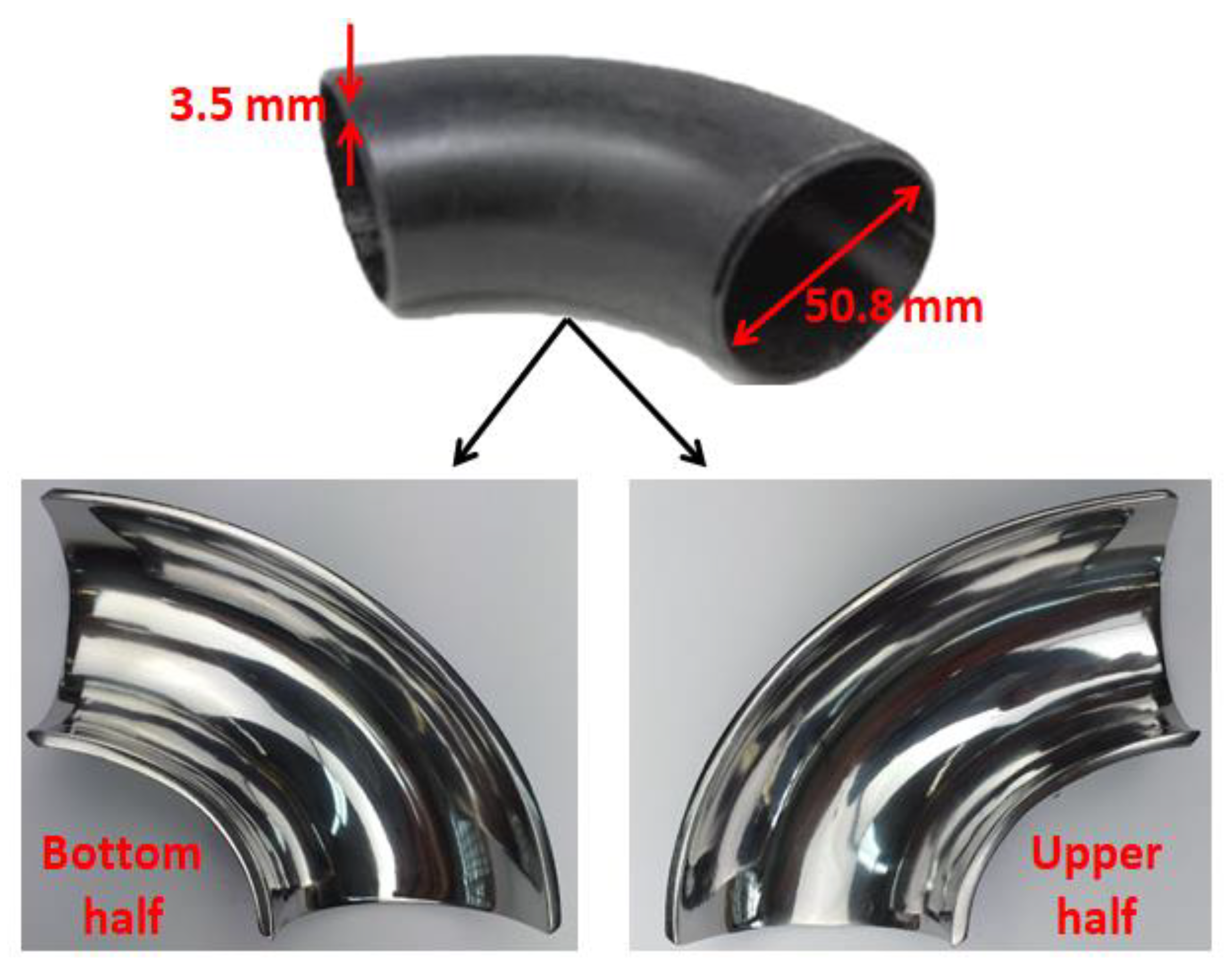


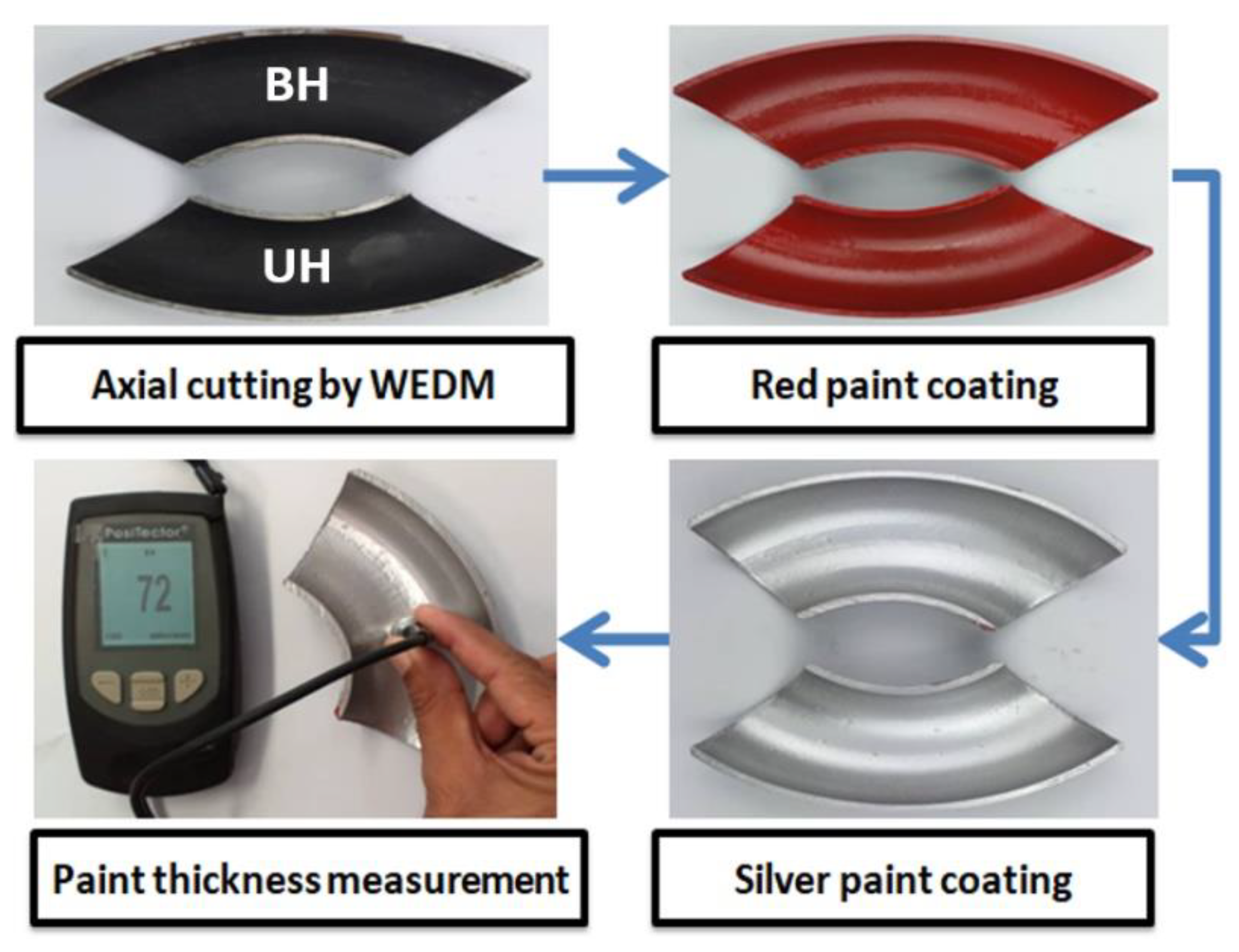
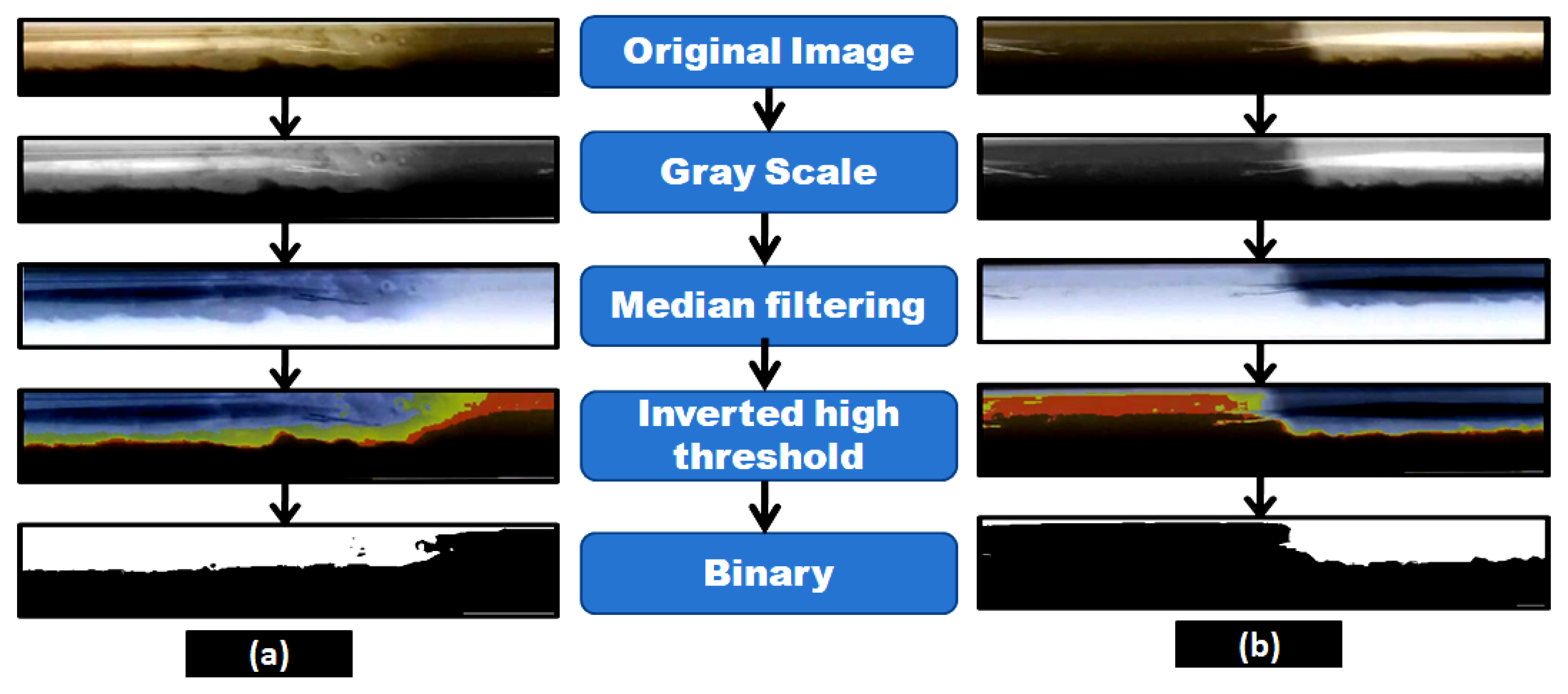
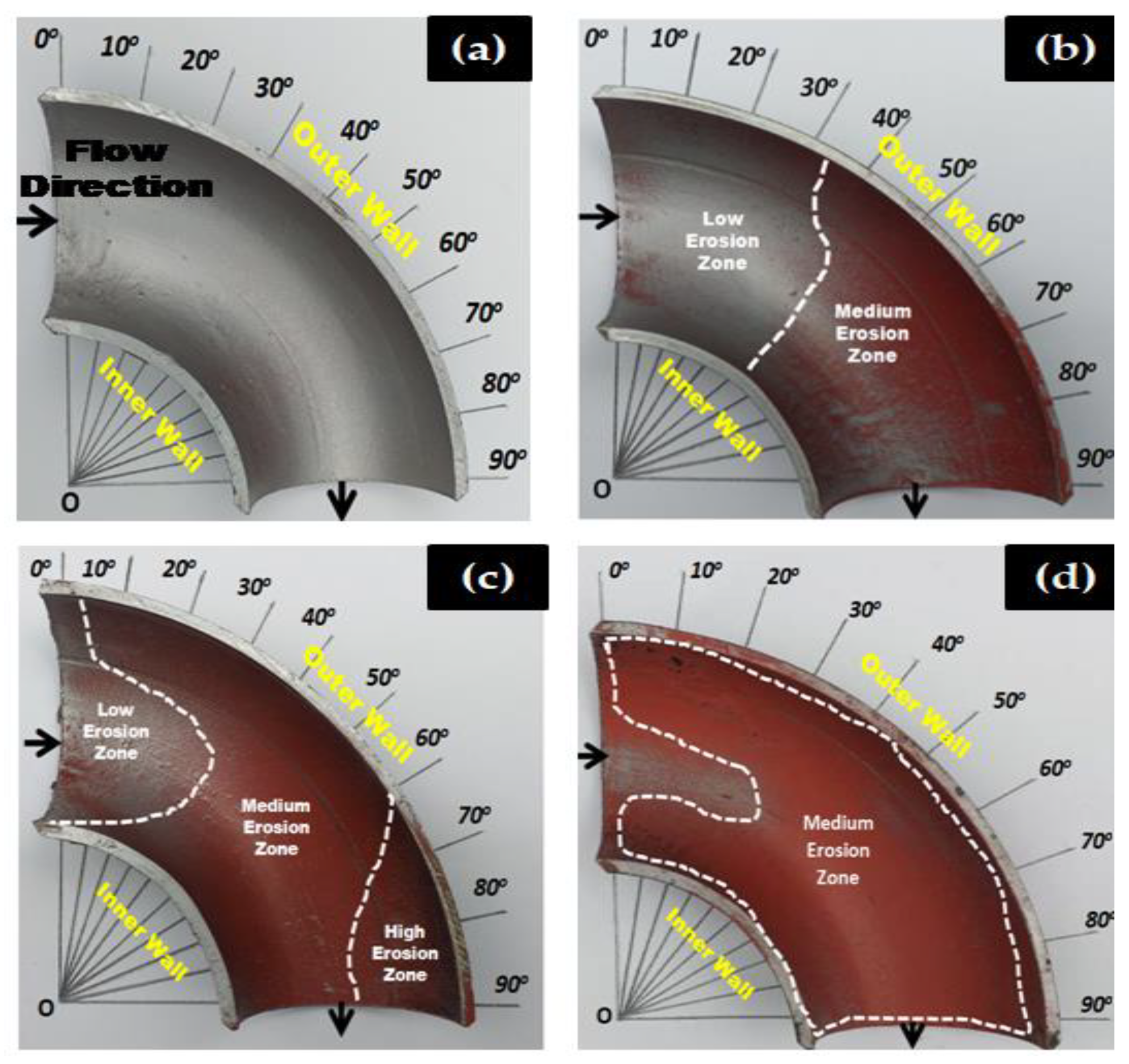


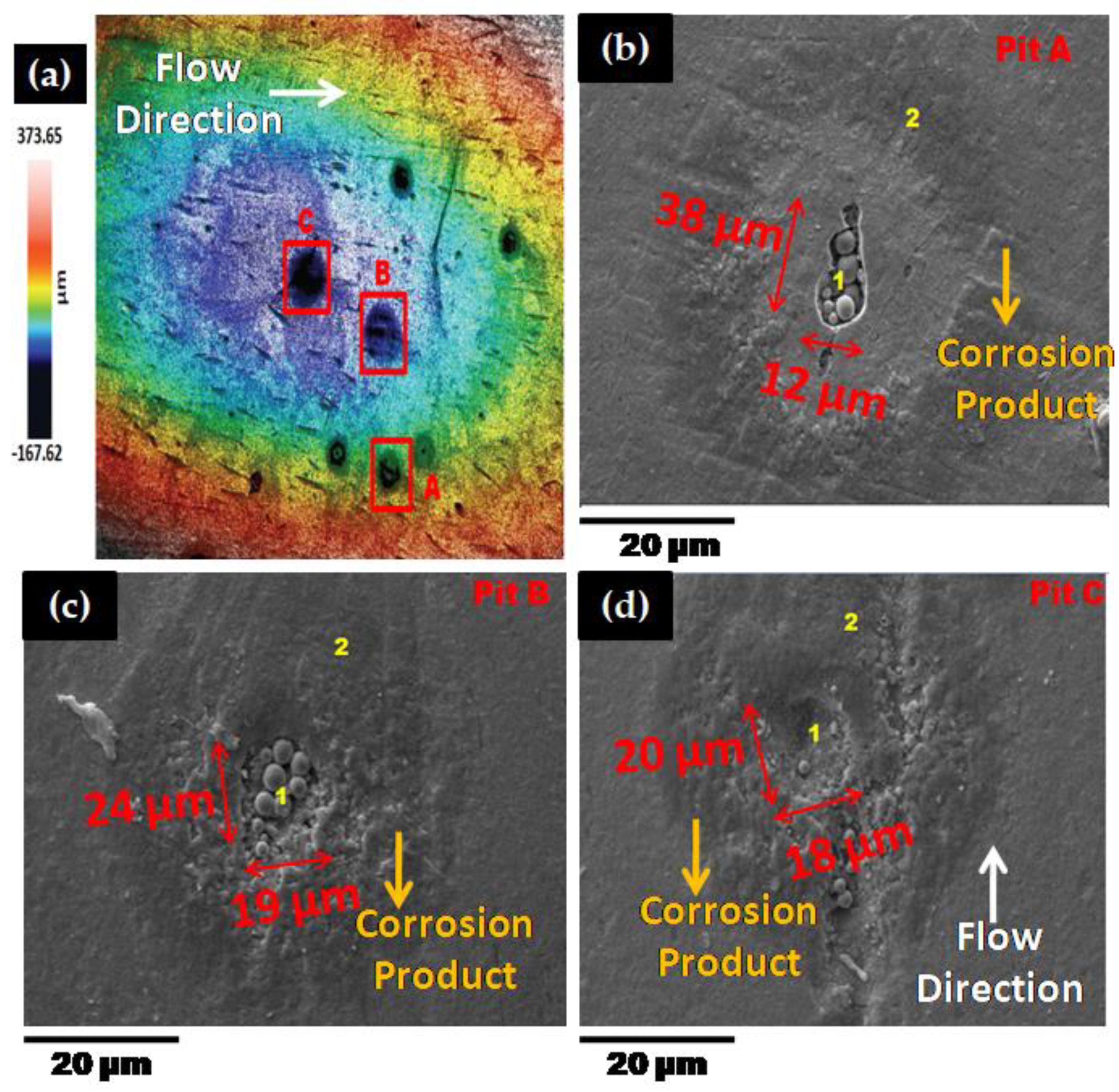

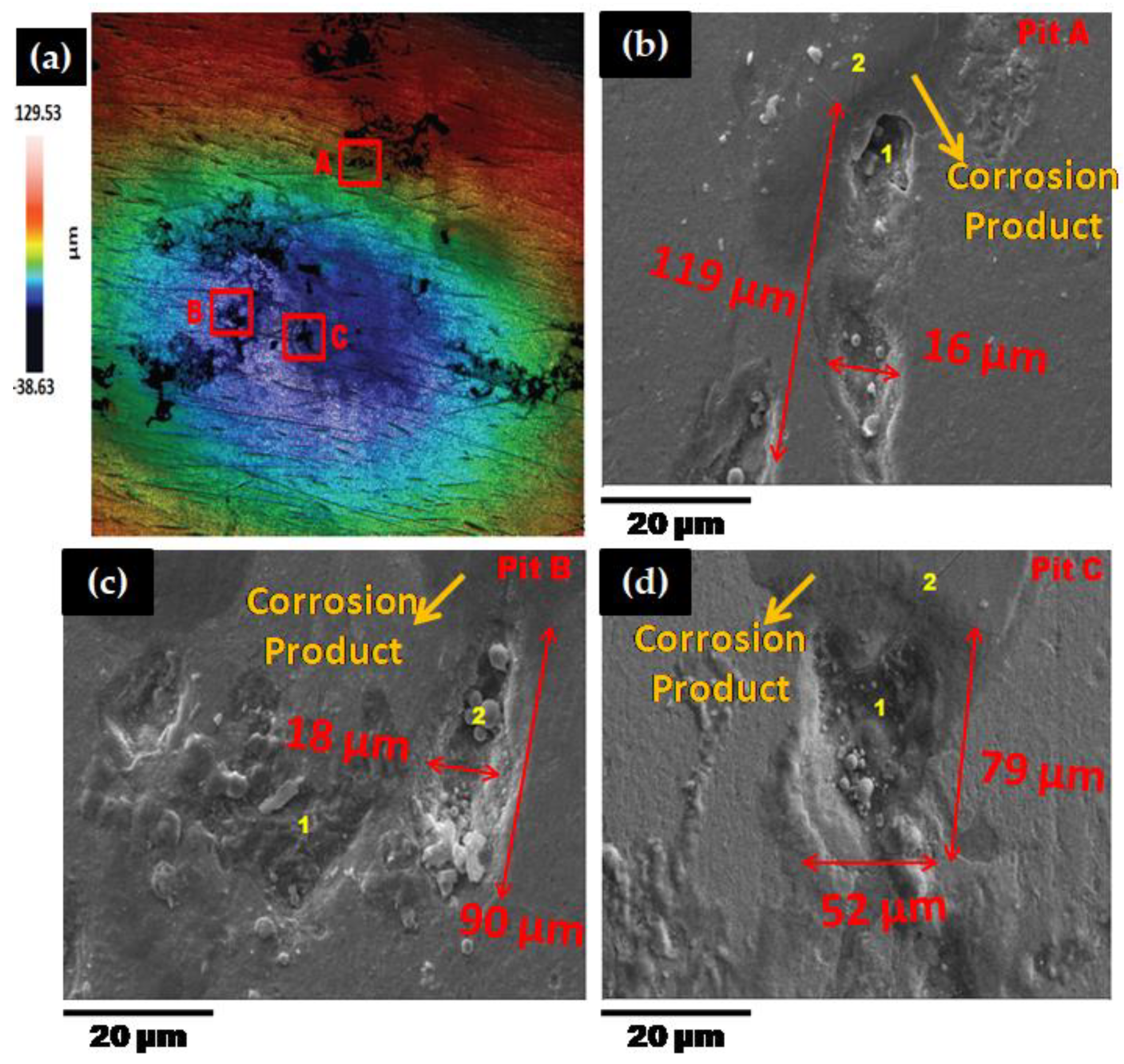
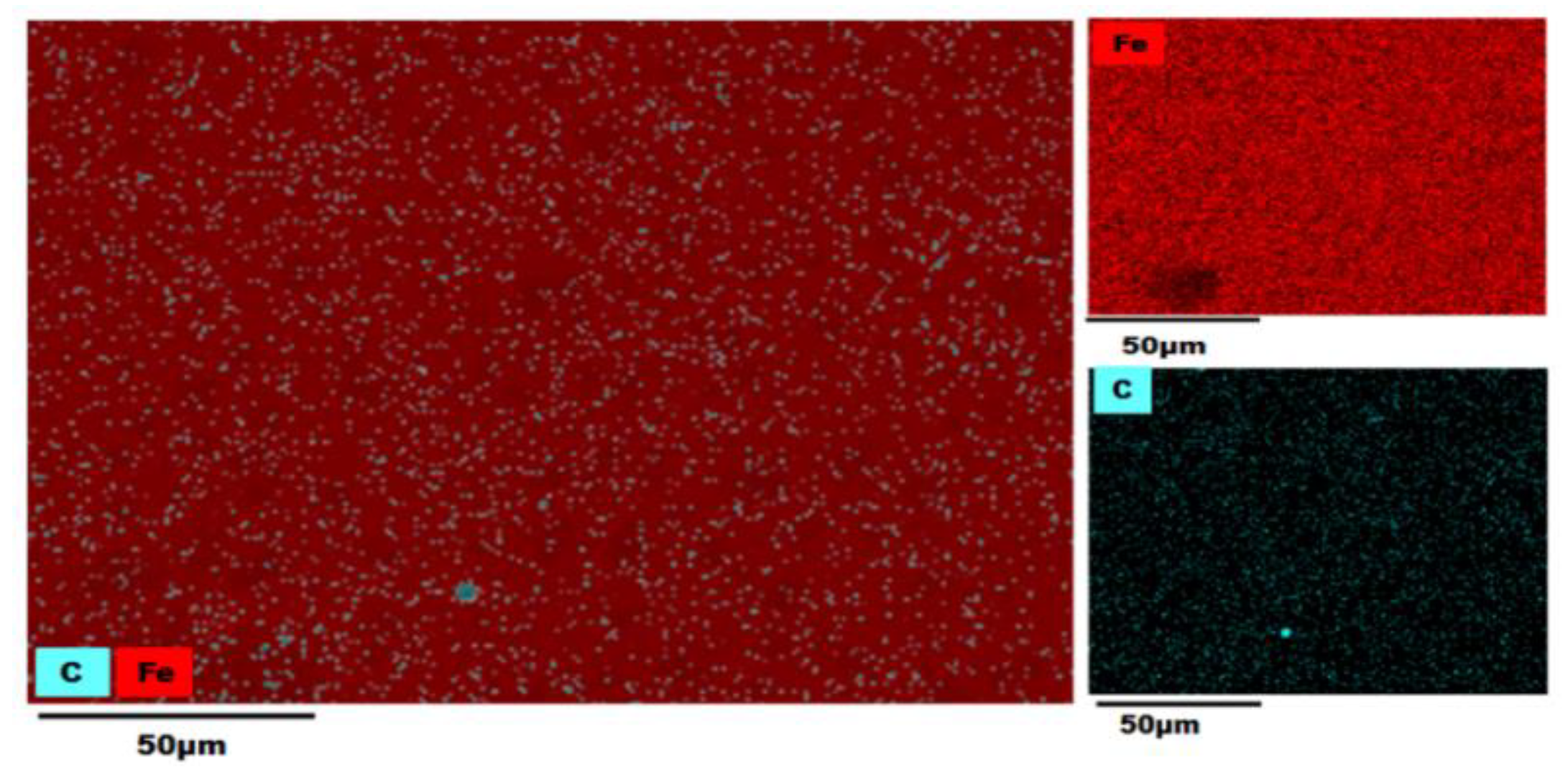
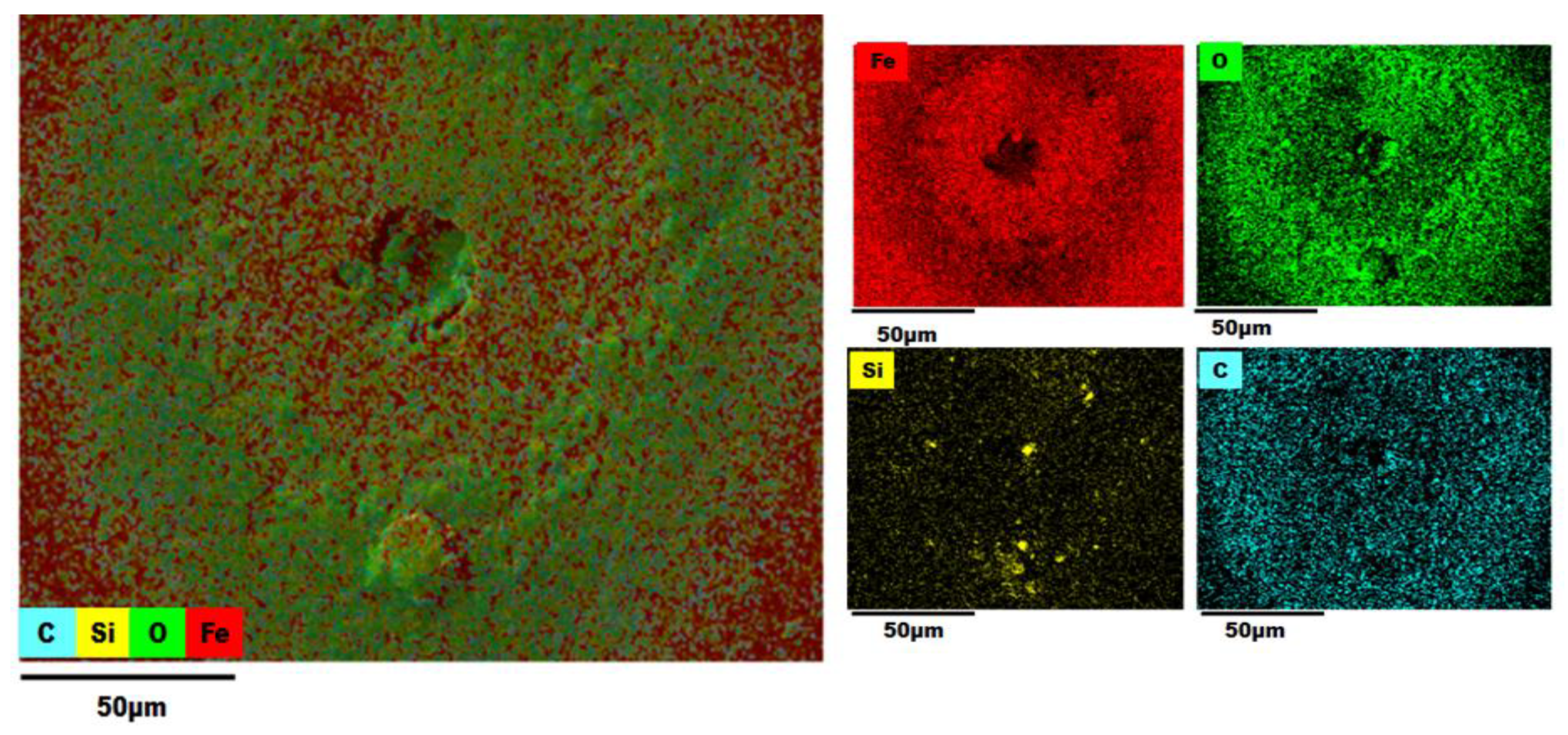
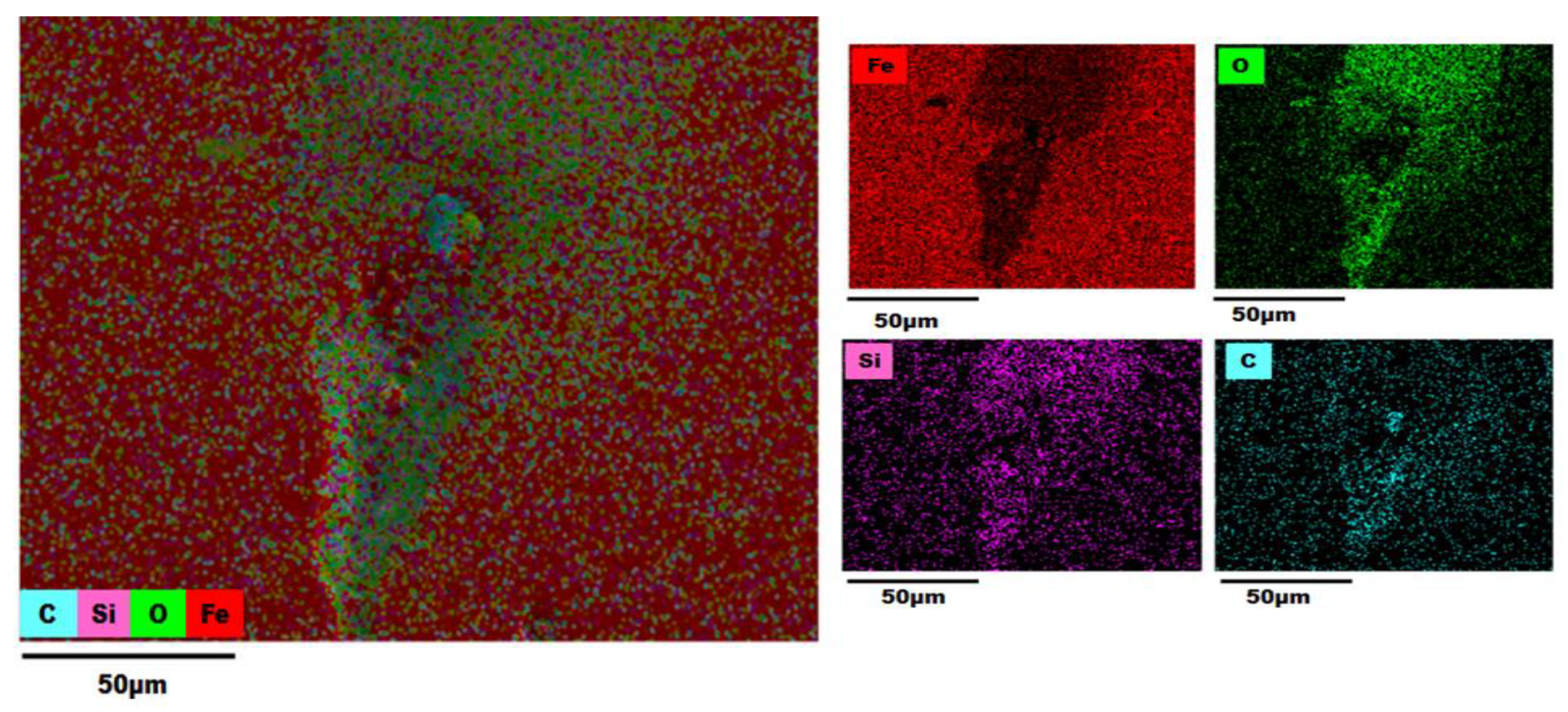

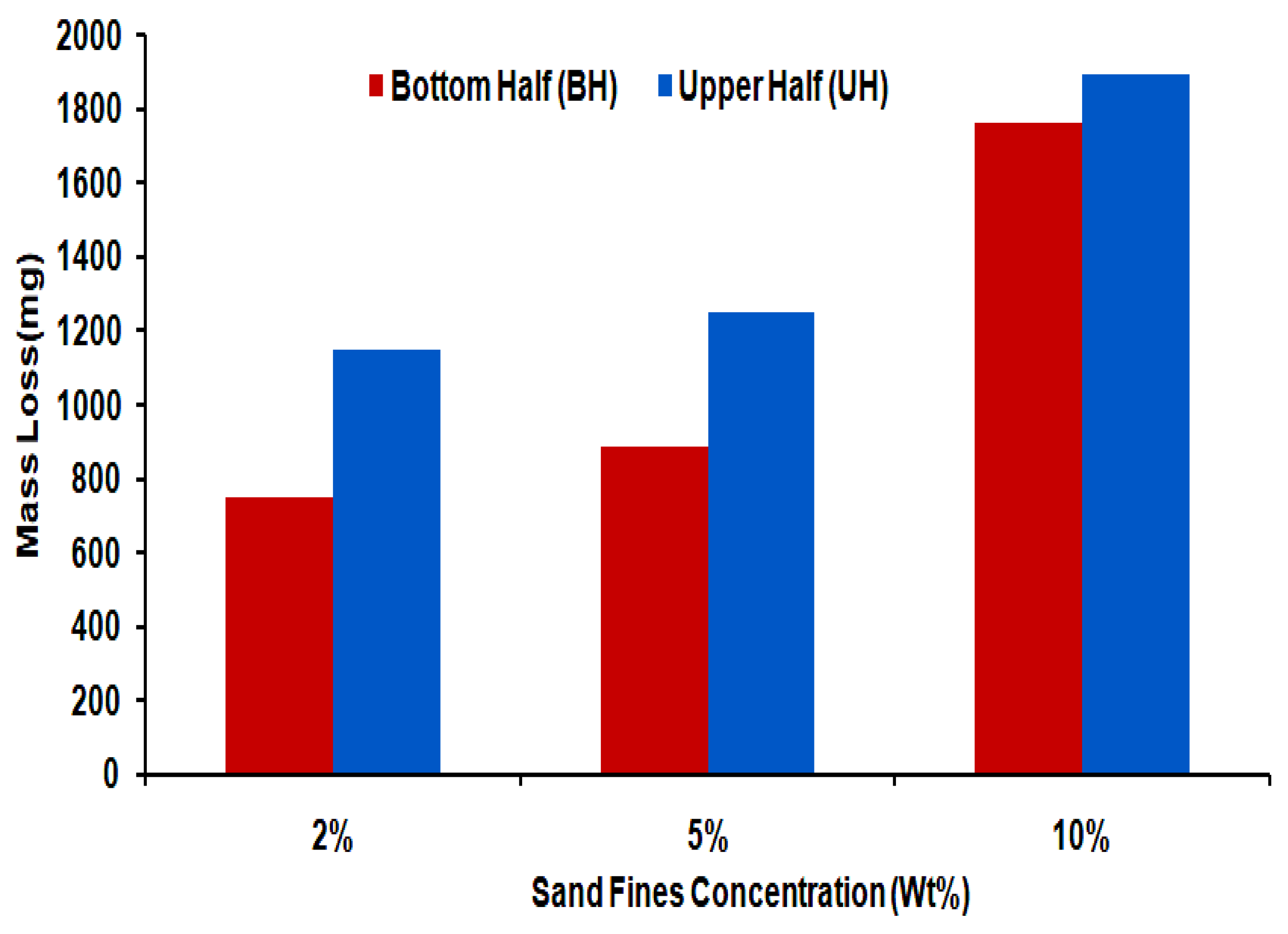
| 1018 CS | ||||||||
|---|---|---|---|---|---|---|---|---|
| Si | Cr | Cu | P | C | S | Ni | Mn | Fe |
| 0.26 | 0.21 | 0.25 | 0.045 | 0.2 | 0.035 | 0.3 | 0.52 | 98.18 |
| SiO2 | Al2O3 | Fe2O3 | Na2O | MgO | CaO |
|---|---|---|---|---|---|
| 98.08 | 1.17 | 0.28 | 0.03 | 0.22 | 0.22 |
| Element | Before Test | Pit A | Pit B | Pit C | |||
|---|---|---|---|---|---|---|---|
| 1 | 2 | 1 | 2 | 1 | 2 | ||
| 2 wt.% sand fines concentration | |||||||
| C | 7.6 | 16.3 | 7.1 | 22.7 | 13.4 | 12.7 | 11.2 |
| O | - | 15.8 | 2.7 | 23.1 | 6.7 | 31.7 | 20.8 |
| Fe | 92.4 | 64.5 | 89.8 | 53.5 | 79.1 | 49.1 | 67.6 |
| Si | - | 1.8 | 0.4 | 0.2 | 0.3 | 3.9 | 0.3 |
| 5 wt.% sand fines concentration | |||||||
| C | 7.6 | 27.8 | 11.8 | 19.1 | 11.0 | 18.1 | 12.7 |
| O | - | 19.5 | 37.4 | 37.6 | 34.6 | 28.3 | 31.7 |
| Fe | 92.4 | 49.6 | 43.0 | 25.4 | 47.2 | 46.4 | 49.1 |
| Si | - | 1.8 | 4.1 | 15.4 | 4.1 | 3.5 | 3.9 |
| 10 wt.% sand fines concentration | |||||||
| C | 7.6 | 22.0 | 12.7 | 35.5 | 10.3 | 23.0 | 10.3 |
| O | - | 29.2 | 31.7 | 23.9 | 31.5 | 28.8 | 33.9 |
| Fe | 92.4 | 41.1 | 49.1 | 36.7 | 51.5 | 42.0 | 47.5 |
| Si | - | 4.0 | 3.9 | 2.1 | 3.9 | 2.4 | 4.1 |
| Material | VSG (m/s) | VSL (m/s) | Flow Time (h) | Particle Size (µm) | Particle Concentration (wt.%) | Mass Loss Rate (kg/m2·s) |
|---|---|---|---|---|---|---|
| 1018 CS | 2.5 | 0.5 | 10 | 50 ± 2 | 2 | 2.77 × 10−6 |
| 1018 CS | 2.5 | 0.5 | 10 | 50 ± 2 | 5 | 3.12 × 10−6 |
| 1018 CS | 2.5 | 0.5 | 10 | 50 ± 2 | 10 | 5.33 × 10−6 |
© 2020 by the authors. Licensee MDPI, Basel, Switzerland. This article is an open access article distributed under the terms and conditions of the Creative Commons Attribution (CC BY) license (http://creativecommons.org/licenses/by/4.0/).
Share and Cite
Khan, R.; H. Ya, H.; Pao, W.; Majid, M.A.A.; Ahmed, T.; Ahmad, A.; Alam, M.A.; Azeem, M.; Iftikhar, H. Effect of Sand Fines Concentration on the Erosion-Corrosion Mechanism of Carbon Steel 90° Elbow Pipe in Slug Flow. Materials 2020, 13, 4601. https://doi.org/10.3390/ma13204601
Khan R, H. Ya H, Pao W, Majid MAA, Ahmed T, Ahmad A, Alam MA, Azeem M, Iftikhar H. Effect of Sand Fines Concentration on the Erosion-Corrosion Mechanism of Carbon Steel 90° Elbow Pipe in Slug Flow. Materials. 2020; 13(20):4601. https://doi.org/10.3390/ma13204601
Chicago/Turabian StyleKhan, Rehan, Hamdan H. Ya, William Pao, Mohd Amin Abd Majid, Tauseef Ahmed, Amir Ahmad, Mohammad Azad Alam, M. Azeem, and Hassan Iftikhar. 2020. "Effect of Sand Fines Concentration on the Erosion-Corrosion Mechanism of Carbon Steel 90° Elbow Pipe in Slug Flow" Materials 13, no. 20: 4601. https://doi.org/10.3390/ma13204601





